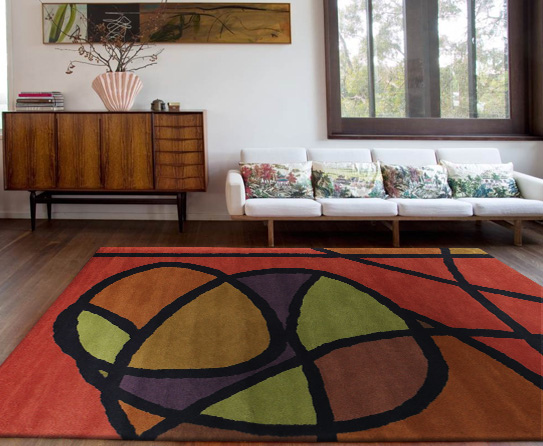Many people in the rug business often get asked as to what rules they should follow when buying a contemporary rug or even an antique rug for that matter. The hardest part is deciding on the size of the rug based on the space available, and with so many opposing opinions from experts this task can be monumental for some. A very popular rule often dispensed by rug store owners is to buy rugs which are large enough to slide right under the front legs of chairs and sofas because it unifies the furniture. But then there are others who belive that all legs of your furniture should be on the rug. So, why don’t we just do away with these so called conventional wisdom type rules and follow a few simple guidelines in determining the size of your rug regardless of if it’s contemporary or otherwise.
Have the Front Legs of your Furniture on it and back Legs off it
There are many gorgeous rooms where the front legs of the furniture are on the rug and the back legs are off it. This particular approach works for a few types of rooms or situations, for instance it works in large rooms especially in old Victorian homes where having a sense of the furniture being connected is important.
The Hybrid Approach
There is what I like to call a hybrid approach with some sofa or table legs on the rug while others are not. This type of setup may work best in rooms where the rug is of a contrasting color or tone as compared to the floor. Maybe the home owner wants to showcase a beautiful floor and need a rug to work in connection with that.
All Legs on a Contemporary Rug
If you want the room to look pulled together i.e. everything sort of forms a functional space then all legs on the rug may work. For instance, in a large living room which doubles as a dining area, all the legs of the dining area may be on the rug while others are off the rug.
Having no Legs on the Rug
This type of setup is best suited for small contemporary rugs. It works best on ones that are meant to just add a touch of pattern to the room. Having none of the furniture touching your rug would be another cool approach with a small size one, it will help you get a clean look.
Have 18 Inches of Open Floor around your Rug
Most people may not realize but this particular rule was the standard for ages. The approach dictates that there has to be around 18 inches between the edges of the rug and the overall perimeter of the room’s walls which is also considered to be a traditional approach. This is a good setup for rooms which are mostly enclosed and are separated from all the surrounding rooms, but not a good choice for open spaces.
Have just an Inch or two of Floor around the Rug
You can run the rug up to just a few inches of the wall in your entire room. But this depends on the decoration decision you make. If the rug is extremely dark in color and your room is small it will make it look smaller yet cozy. This is why its best suited for a large room.
Running the Rug around 18 Inches around your Bed
Now in order for the area around your bed to look balanced it has to extend beyond the sides by at least ten inches if not eighteen inches. A king or queen size bed should have twelve inches at least. You can extend the rug even further if the bedroom is large but any less would make the rug look insignificant.
Cover the Overall Walking Area
A rule of thumb suggests that a contemporary rug needs to cover the majority of a regularly trafficked area i.e. the hallway or perhaps the entry way. If it’s a high traffic area make sure that both feet are planted onto the surface of the rug.
Combining Rugs
Leading rug sellers like Scatter Mats suggest another approach which can use multiple area rugs. This is highly effective for rooms that are large enough with more than one seating clusters.
Mark has been in the rug business for over a decade. He currently runs one of the largest contemporary rugs sales business in Australia. His years of experience allows him to advise people on best practices and which rugs will help their rooms stand out. He is also a regular contributor to various interior decoration blogs.





